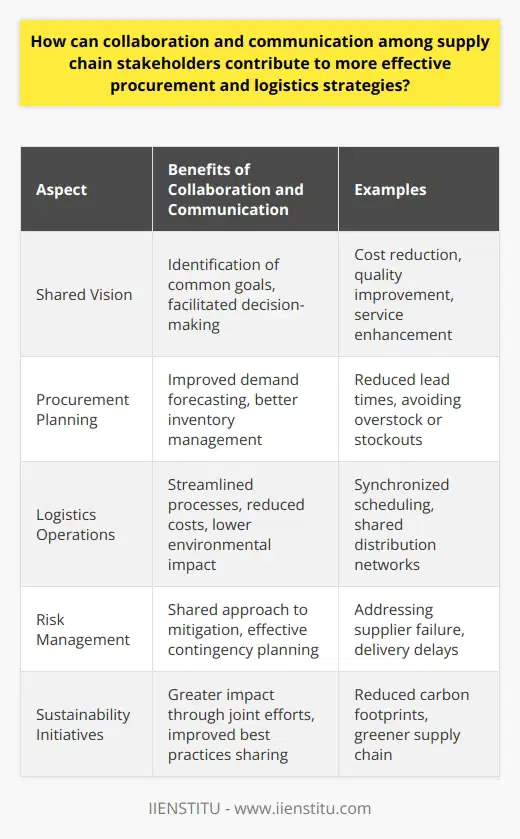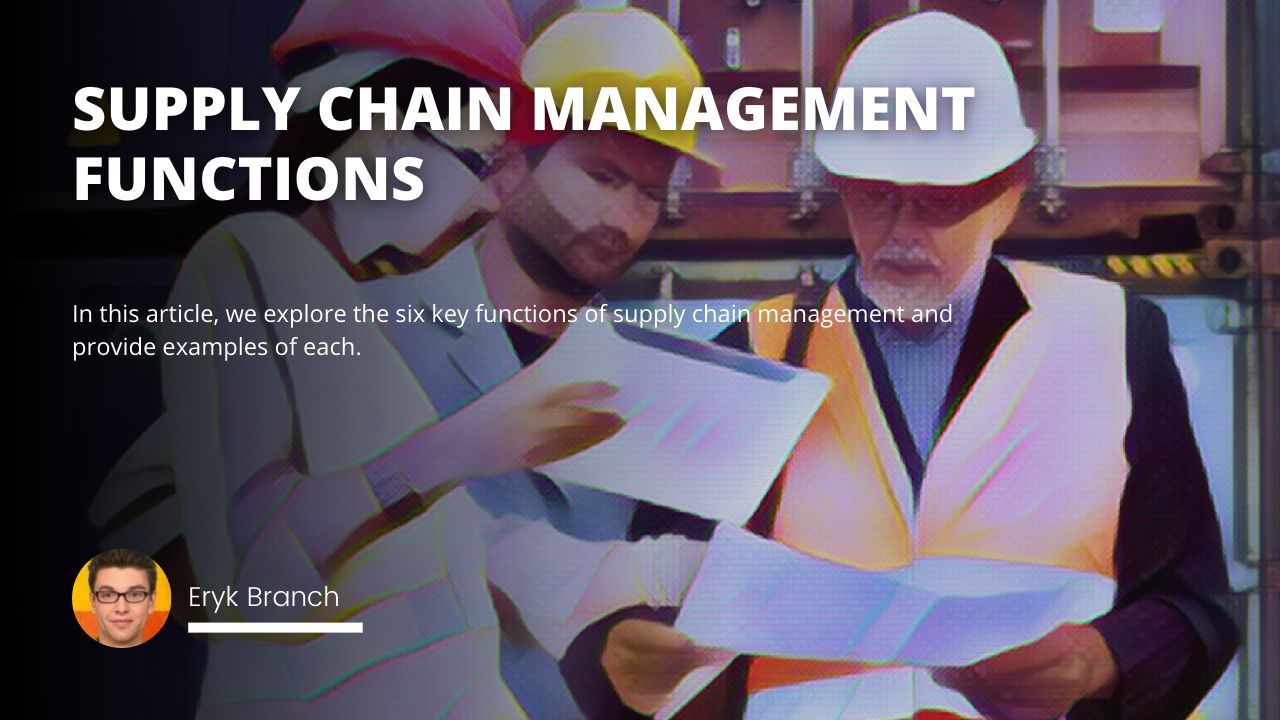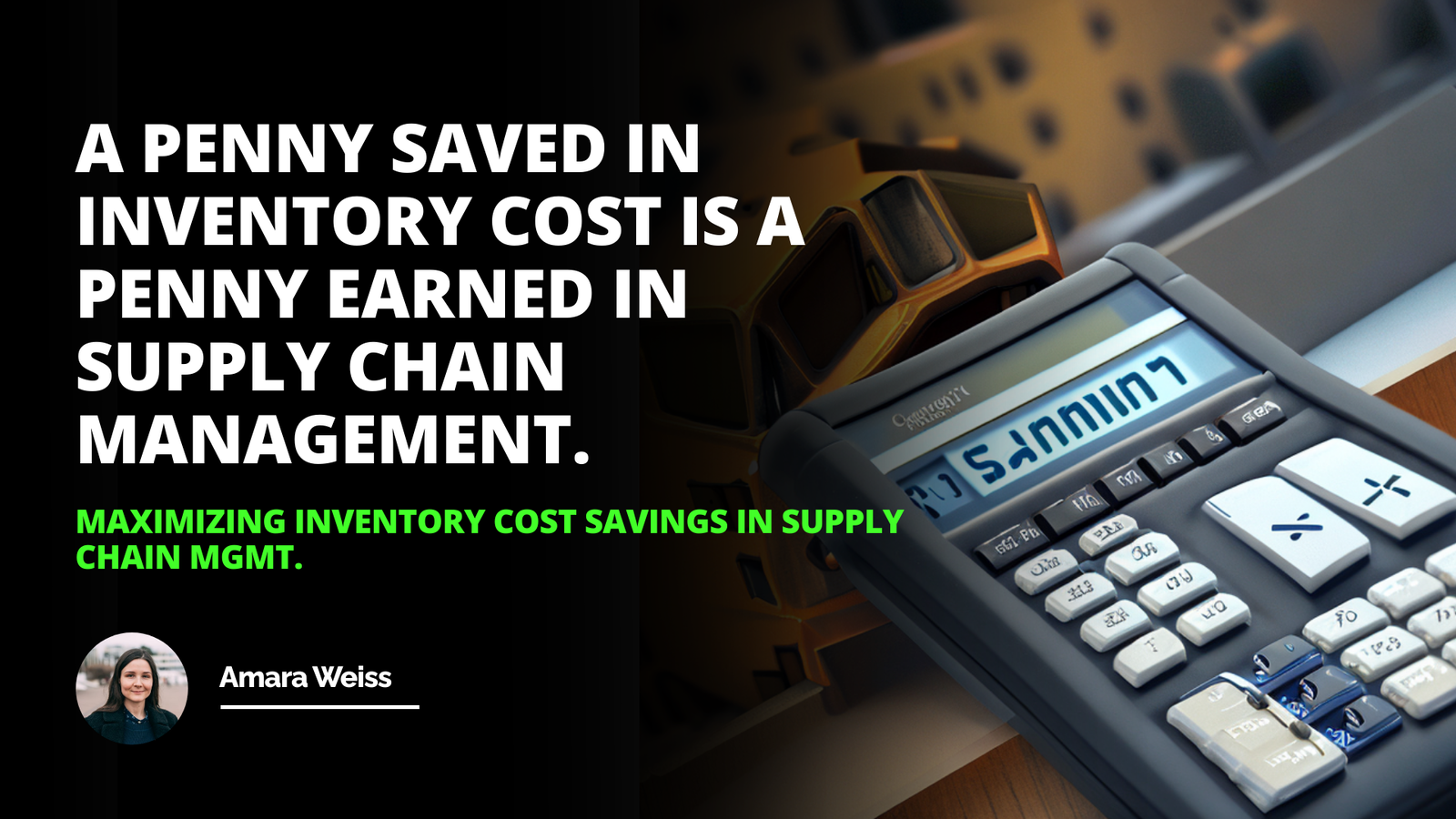
I still remember the early days of my career in supply chain management. Fresh out of university, I joined a manufacturing company that was struggling to keep up with customer demand. One of my first tasks was to explore ways to optimize our operations. Little did I know that the concept of increasing batch size would become a pivotal strategy in our journey toward efficiency.
In this article, we'll delve into the potential benefits and drawbacks of increasing batch size to optimize supply chain management. We'll explore how procurement and logistics play crucial roles and share insights from real-world experiences and academic studies. Whether you're a seasoned professional or new to the field, understanding the impact of batch size on your supply chain can make a significant difference.
Introduction
Procurement & Logistics
Optimizing Supply Chain Management
Benefits of Increasing Batch Size
Conclusion
Procurement and Logistics: The Backbone of Supply Chain Management
Before we dive deeper, let's take a moment to appreciate the vital roles that procurement and logistics play in the realm of supply chain management. These two departments are the lifeblood of any organization that relies on moving goods from point A to point B.
The Role of Procurement
The procurement team is on the frontline of sourcing the best materials at the most competitive prices. They're the ones negotiating with suppliers, assessing risks, and ensuring that the company gets the best bang for its buck. In today's globalized world, this often means dealing with suppliers from low-cost regions to minimize expenses.
I remember when our procurement team scored a massive win by negotiating a long-term contract with a key supplier. Not only did we secure a significant discount, but we also established a strong partnership that would benefit us for years to come. It was a testament to the importance of supplier relationship management in the grand scheme of supply chain optimization.
The Importance of Logistics
On the other hand, the logistics department ensures that these materials reach their destinations efficiently. This involves coordinating transportation, managing supply chain activities, and ensuring timely delivery. Logistics is not just about moving goods; it's about optimizing the entire process to reduce costs and improve customer satisfaction.
I recall a particularly challenging project where we had to deliver a large shipment to a remote location within a tight deadline. Our logistics team worked tirelessly to coordinate multiple modes of transportation, navigating through customs, and ensuring that the goods arrived intact and on time. It was a prime example of how logistics efficiency can make or break a company's reputation.
Optimizing Supply Chain Management Through Batch Size Adjustment
One strategy that often comes into play when trying to optimize supply chain management techniques is adjusting the batch size of orders. But what does increasing batch size actually entail, and how does it impact both procurement and logistics?
Economies of Scale
When we increase the batch size, we often benefit from economies of scale. Buying in larger quantities usually means getting a lower cost per unit. I recall a time when we decided to bulk purchase raw materials. Not only did we secure a significant discount from our supplier, but we also locked in favorable terms for future orders. This move was celebrated in the procurement department as a big win.
Efficient supply chain management is the key to successful procurement and logistics.
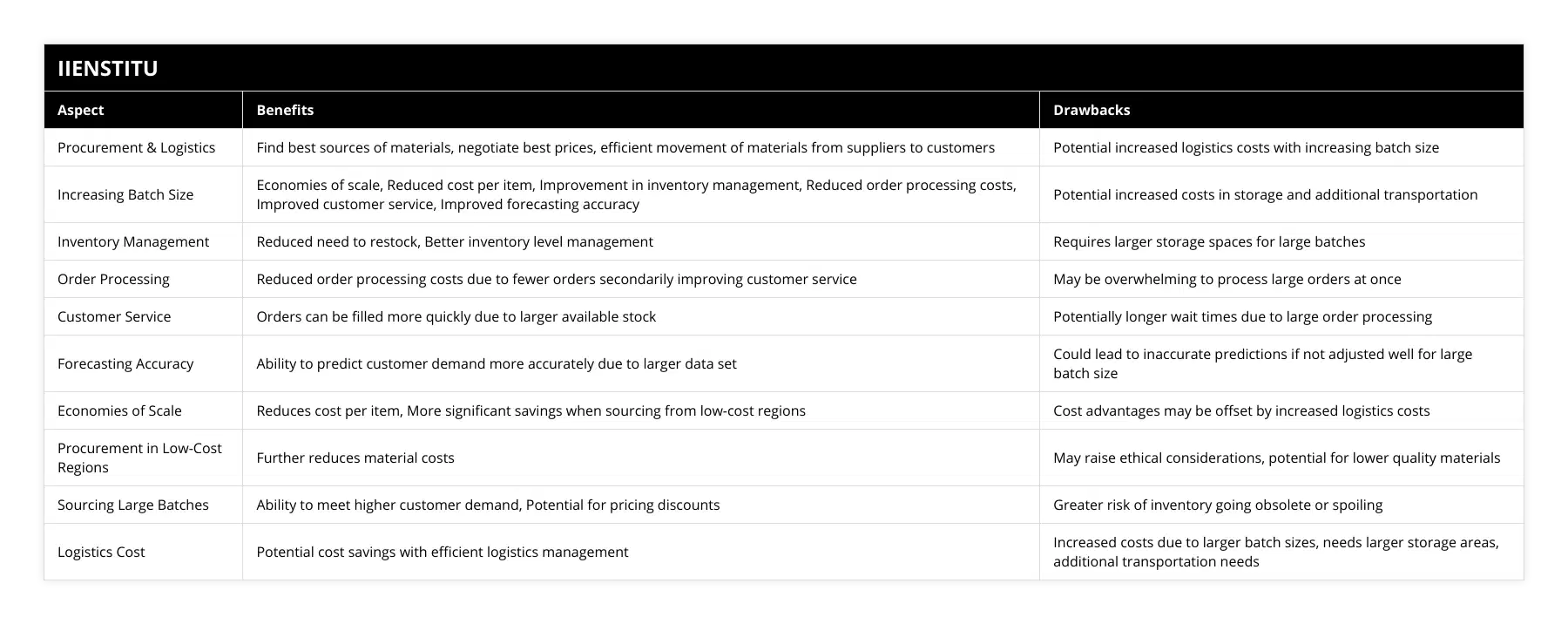
Enhanced Supplier Relationships
Larger orders can strengthen relationships with suppliers. They see you as a valuable customer and, in turn, may offer better service levels, priority production scheduling, or even share insights about market trends that could benefit your company.
The Potential Drawbacks of Increasing Batch Size
However, it's not all sunshine and roses. While increasing batch size has its perks, it also brings along some challenges, especially for the logistics team.
Increased Logistics Costs
One of the immediate consequences of larger batch sizes is the increase in logistics costs. Here's why:
Storage Requirements: More inventory means more space is needed. This could lead to higher warehousing costs or the need to invest in additional storage facilities.
Transportation Challenges: Larger batches may require more complex transportation solutions, potentially increasing shipping costs.
Risk of Obsolescence: Holding more inventory increases the risk that some items may become obsolete, especially in fast-moving industries.
I vividly remember when our company decided to increase the batch size of a component used in one of our electronics products. Due to delays in product launch, we ended up with a surplus of components that became outdated quickly, leading to significant losses.
Balancing the Scales: Weighing Benefits and Drawbacks
So, how do companies decide whether increasing batch size is the right move? It boils down to a careful analysis of the potential benefits versus the possible drawbacks.
Benefits of Increasing Batch Size
1- Improved Inventory Management: By having larger quantities on hand, companies can better meet customer demand without the constant need to reorder. This is particularly beneficial during peak seasons.
2- Reduced Order Processing Costs: Processing fewer, larger orders can reduce administrative costs associated with order placement, invoicing, and payment processing.
3- Improved Customer Service: With more stock available, companies can fulfill orders faster, leading to higher customer satisfaction.
4- Enhanced Forecasting Accuracy: Larger batch sizes can smooth out demand variability, making it easier to predict and plan for future needs.
Drawbacks of Increasing Batch Size
1- Higher Holding Costs: Increased inventory leads to higher costs for storage, insurance, and capital tied up in stock.
2- Logistics Complexity: Managing larger batches can complicate transportation and handling processes.
3- Risk of Waste: Perishable goods or items with a short life cycle may spoil or become obsolete.
Real-World Applications and Examples
Case Study: Automotive Industry
In the automotive industry, companies often grapple with the decision of batch sizes. An increase in batch size can lead to lower costs per unit, but the demand for customization and just-in-time delivery has shifted the preference toward smaller batches.
Electronic Supply Chain Management
In electronics, electronic supply chain management requires balancing batch sizes carefully. Technology evolves rapidly, and holding large inventories can result in obsolete stock. Companies like Apple are known for their efficient supply chain department that minimizes inventory while meeting global demand.
Strategies to Mitigate Drawbacks
To reap the benefits of increased batch sizes while minimizing risks, companies can adopt several strategies:
1- Implementing Advanced Inventory Systems: Utilizing the best Gantt chart for project management can help in planning and visualizing inventory levels, production schedules, and shipping timelines.
2- Leveraging Supply Chain Management Software: SCM management tools can provide real-time data, predictive analytics, and automation to optimize both procurement and logistics processes.
3- Collaboration with Suppliers: Developing strong relationships can lead to better terms, shared risk, and improved communication.
4- Flexible Supply Chain Design: Designing a chain of supply management that can adapt to changes in demand or supply conditions can reduce risks associated with larger batch sizes.
The Role of Technology in Supply Chain Optimization
Technology plays a pivotal role in modern supply chain management management. From blockchain for transparency to AI for predictive analytics, embracing technological solutions can enhance efficiency.
Electronic Supply Chain Management
Electronic supply chain management involves integrating technology into all aspects of the supply chain. This can include:
Automation of Processes
Real-Time Tracking
Data Analytics for Forecasting
Conclusion
Reflecting on my journey through the world of supply chain management, I can attest that there's no one-size-fits-all answer to whether increasing batch size is the right strategy. It's a decision that requires careful consideration of both the benefits and drawbacks.
Companies must analyze their specific situation, considering factors like industry dynamics, demand variability, storage capacity, and financial implications. By leveraging tools like the best Gantt chart for project management, utilizing advanced SCM supply, and fostering strong supplier relationships, organizations can make informed decisions.
In the end, optimizing supply and chain management is about finding the right balance. Whether through increasing batch sizes or other strategies, the goal remains the same: delivering value to customers efficiently and effectively.
References
1- Christopher, M. (2016). Logistics & Supply Chain Management (5th ed.). Pearson Education Limited.
2- Chopra, S., & Meindl, P. (2019). Supply Chain Management: Strategy, Planning, and Operation (7th ed.). Pearson.
3- Simchi-Levi, D., Kaminsky, P., & Simchi-Levi, E. (2008). Designing and Managing the Supply Chain: Concepts, Strategies, and Case Studies (3rd ed.). McGraw-Hill/Irwin.
4- Johnson, P. F., Leenders, M. R., & Flynn, A. E. (2017). Purchasing and Supply Management (15th ed.). McGraw-Hill Education.
Frequently Asked Questions
What strategies can be employed to optimize supply chain management procurement and logistics?
Supply chain management, procurement, and logistics are two critical components of a successful business. This blog post will discuss the strategies employed to optimize supply chain management procurement and logistics.
One of the most important strategies is ensuring the supply chain is well-structured. This means that the entire procurement and logistics process should be well-defined and documented. This includes clearly understanding the roles and responsibilities of each member of the supply chain, as well as the processes and procedures for ordering, shipping, and receiving goods. It is also essential to ensure that the supply chain is well-integrated. This means that the different components of the chain are working together in a coordinated manner.
Another strategy to optimize supply chain management procurement and logistics is to improve the visibility of the supply chain. This means that the different players in the chain clearly understand the status of their orders. This can be done through the use of tracking systems and software. This will enable the different players in the chain to get real-time updates on the status of their orders, as well as provide insights into potential delays or issues.
Thirdly, it is essential to focus on process automation. Automation can help to reduce the manual labor associated with procurement and logistics and improve the accuracy and efficiency of the process. Automation can also help to reduce costs related to the supply chain by reducing the need for manpower and resources.
Finally, it is essential to ensure that the supply chain is secure. This means that the processes and procedures should be designed and implemented so that any vulnerabilities or threats to the supply chain can be identified and addressed quickly and effectively.
In conclusion, several strategies can be employed to optimize supply chain management procurement and logistics. These strategies include ensuring that the supply chain is well-structured, improving the visibility of the supply chain, focusing on process automation, and ensuring that the supply chain is secure. By following these strategies, businesses can ensure that their supply chain is optimized for maximum efficiency and productivity.
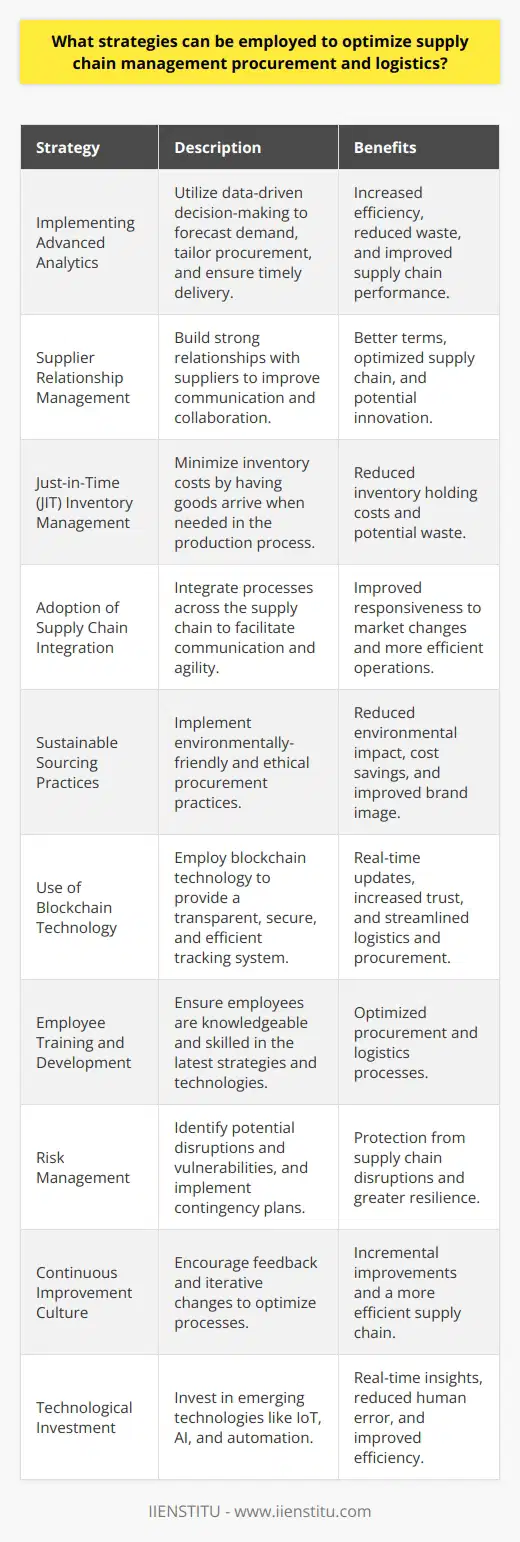
How can increasing batch size benefit supply chain management procurement and logistics?
Increasing batch size is a powerful tool in supply chain management, procurement, and logistics. It has the potential to reduce inventory costs, increase efficiency, and improve customer service. Batch size is the number of items or quantity of material grouped for a particular purpose or job. Increasing the batch size can result in many benefits for the supply chain.
The primary benefit of increasing batch size is the reduction in inventory costs. This is because larger batches require fewer orders to be placed, which reduces the number of times goods need to be shipped and handled. Reducing the number of orders and shipments, it reduces the amount of storage space that is required, as well as the amount of inventory that has to be kept in stock. This, in turn, reduces the amount of money spent on storing and managing the inventory. In addition, inventory costs are further reduced by the fact that larger batches allow for higher purchase discounts to be negotiated with suppliers.
Increasing batch size also has the potential to increase efficiency. This is because larger batches require fewer orders to be placed, which reduces the amount of paperwork and administrative tasks involved in managing the supply chain. This reduces the amount of time spent on managing the supply chain, which allows more time to be spent on other activities that add value to the business. Furthermore, larger batches allow for more items to be shipped together, reducing the number of shipments and, thus, the amount of time spent on preparing and sending the orders.
Finally, increasing batch size can also improve customer service. Reducing the number of orders and shipments minimizes the time spent on preparing and sending orders. This, in turn, reduces the time spent waiting for orders to be delivered, improving the customer experience. Furthermore, larger batches allow for higher purchase discounts to be negotiated with suppliers, which can result in more cost-effective products being offered to customers.
In conclusion, the increasing batch size is a powerful tool in supply chain management, procurement, and logistics. It has the potential to reduce inventory costs, increase efficiency, and improve customer service. Companies should consider the benefits of increasing batch size to gain a competitive advantage.
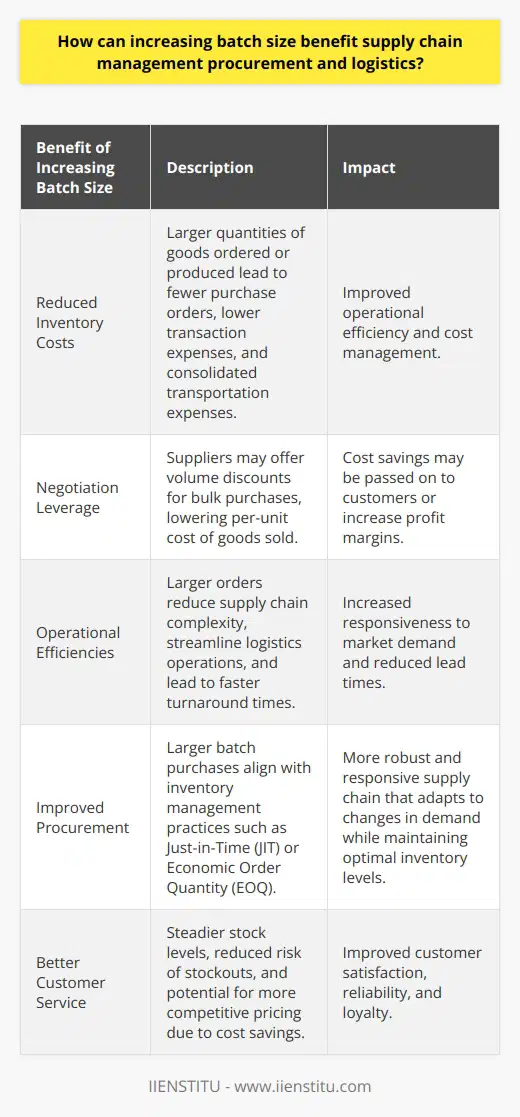
What are the potential risks associated with optimizing supply chain management procurement and logistics?
When businesses decide to optimize their supply chain management, they are likely to encounter a variety of risks and challenges. These risks can include significant financial losses, disruption of the supply chain, and decreased customer satisfaction.
Financial Losses: One of the most significant risks associated with optimizing supply chain management is the potential for significant financial losses. Optimizing supply chain management can involve large investments in technology, personnel, and other resources. If the optimization efforts fail to produce the desired results or unexpected problems arise, the business may suffer significant financial losses.
Disruption of the Supply Chain: Another potential risk is disruption of the supply chain. Optimizing supply chain management can involve changes to the existing system, which can lead to disruptions in the flow of goods and services. This can cause delivery delays or result in a decrease in customer satisfaction.
Decrease in Customer Satisfaction: Finally, optimizing supply chain management can decrease customer satisfaction. Customers are often accustomed to a certain level of service, and any changes to the supply chain system may reduce the quality of service they receive. This can ultimately lead to a decrease in customer loyalty and lower profits.
In conclusion, businesses should know the potential risks associated with optimizing supply chain management. These risks include financial losses, disruption of the supply chain, and a decrease in customer satisfaction. As such, businesses should carefully evaluate the potential risks and benefits of any optimization efforts before implementing them.
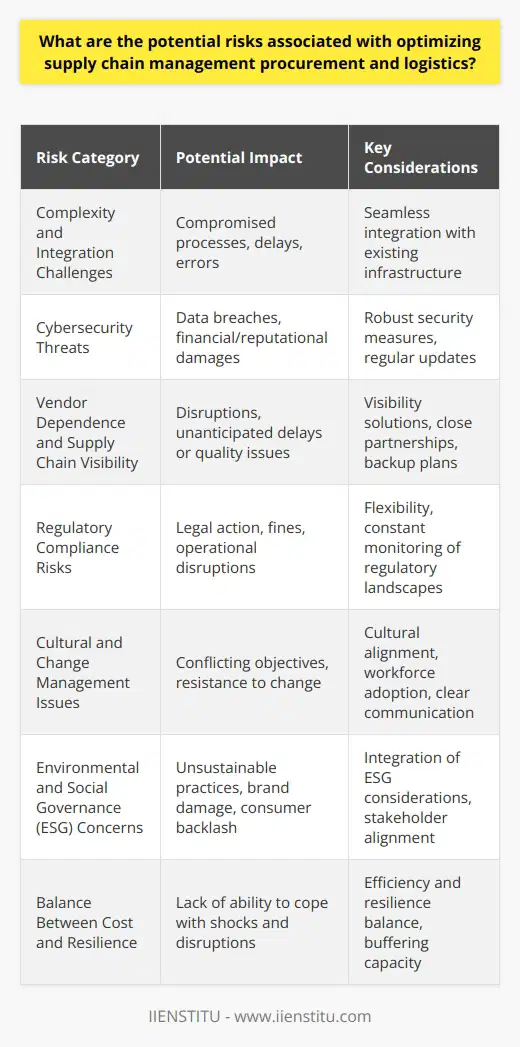
What is the role of technology in optimizing supply chain management procurement and logistics?
Role in Procurement
Technology plays a critical role in optimizing supply chain management by streamlining procurement processes. Digital tools and platforms enable businesses to automate the procurement cycle, reducing the time required to identify, select, and engage with suppliers. This streamlined process results in reduced costs and enhanced supplier relationships.
Enhancement in Data Analytics
Furthermore, advancements in data analytics have allowed supply chain managers to make more informed decisions regarding supplier selection and purchasing strategies. By utilizing these technologies, businesses can identify and mitigate potential risks, foresee demand fluctuations, and effectively manage their inventories, driving efficiency across the supply chain.
Automation of Logistics Operations
The role of technology in logistics operations is also critical, as it allows for greater visibility and control over the movement of goods. Radio Frequency Identification (RFID), Internet of Things (IoT) devices, and GPS tracking enable real-time monitoring of shipments, resulting in improved route planning, reduced transit times, and minimized risks associated with transportation.
Integration and Collaboration
In addition to these direct benefits, technology enhances supply chain management through better integration and collaboration among stakeholders. Digital platforms enable end-to-end visibility, facilitating greater coordination between suppliers, manufacturers, distributors, and retailers. This increased transparency results in better decision-making and more efficient use of resources.
Adaptation to Market Changes
Finally, technology allows supply chain managers to adapt quickly to market changes, as it provides the necessary tools to respond to evolving customer demands, changing regulations, and competitor actions. By embracing technological advancements, businesses can develop agile supply chain strategies and maintain their competitive edge.
In conclusion, technology plays a pivotal role in optimizing supply chain management by improving procurement, logistics, data analytics, and stakeholder collaboration. Embracing these innovations allows businesses to maintain a competitive advantage in a rapidly changing market landscape.
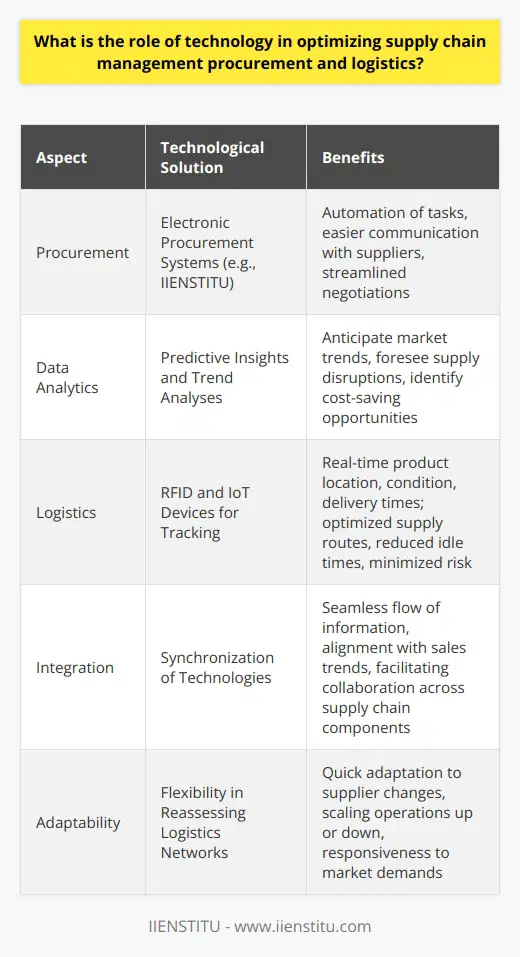
In what ways can data analysis and business intelligence (BI) tools enhance decision-making in logistics and procurement?
Enhanced Informed Decision-Making
Data analysis and business intelligence (BI) tools can significantly improve decision-making in logistics and procurement by providing timely, accurate, and actionable insights. These tools help organizations analyze large volumes of structured and unstructured data, revealing patterns, trends, and correlations that can potentially impact their supply chain processes.
Reduction in Costs and Risks
Data analysis and BI tools can help identify inefficiencies in the procurement process, leading to cost reductions. By analyzing historical and real-time data, these tools can aid in optimizing routes, reducing transportation costs, and minimizing warehouse storage fees. Additionally, they can help companies better understand and proactively manage risks associated with supplier reliability, shipment delays, and market fluctuations.
Improved Demand Forecasting
Data analysis and BI tools can be instrumental in improving demand forecasting. By processing and understanding historical sales patterns and trends, organizations can predict future demand with more accuracy. This helps companies make strategic procurement decisions, minimize stockouts, and reduce the risks associated with overstocking inventory.
Strengthened Supplier Selection and Negotiations
Data analysis and BI tools can help logistics and procurement managers evaluate and select suppliers based on their performance metrics, such as on-time delivery, product quality, and cost competitiveness. These tools also assist in monitoring and comparing supplier performance continuously, allowing organizations to engage in better negotiations, establish long-term strategic partnerships, and ultimately realize more value from their contracts.
Increased Collaboration and Visibility
BI tools can enhance cross-functional collaboration by creating a centralized repository of data accessible to various departments within an organization. This enables better visibility and sharing of information, leading to more informed decision-making and greater alignment of procurement and logistics strategies with overall business objectives.
Overall, data analysis and business intelligence tools play a critical role in enhancing decision-making in logistics and procurement. By leveraging their capabilities, organizations can achieve cost savings, mitigate risks, improve supplier relations, and make more informed decisions that ultimately drive business growth.
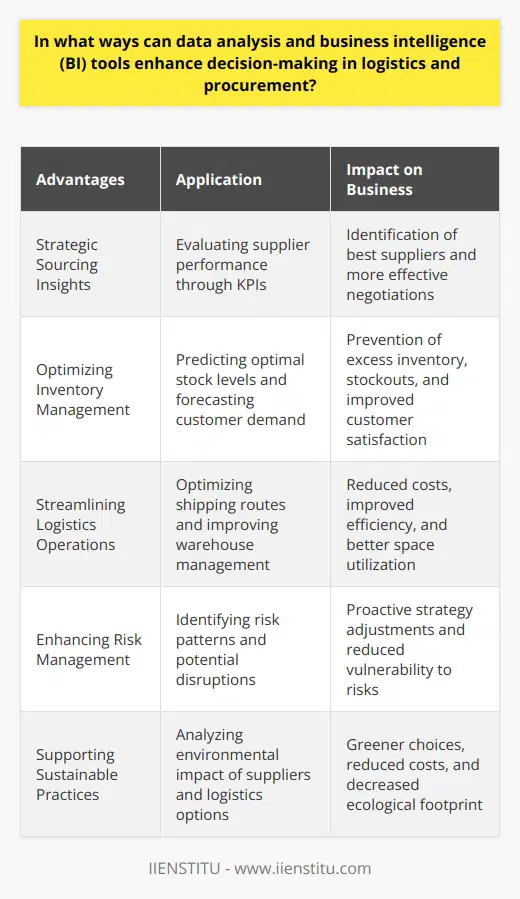
How can the integration of environmental and social sustainability measures contribute to the overall success of supply chain management in procurement and logistics?
Supply Chain Sustainability Integration
The integration of environmental and social sustainability measures can significantly contribute to the overall success of supply chain management in procurement and logistics by enhancing the efficiency of processes, reducing costs, and improving the corporate image. These positive outcomes can ultimately lead to an increase in market demand, profitability, and long-term competitive advantage.
Environmental Advantages
Integrating environmentally-friendly practices into procurement and logistics reduces the use of natural resources, promotes sustainable products, and mitigates climate change. For example, implementing energy-efficient transportation methods, reducing packaging waste, and using renewable materials can all contribute to lowering the ecological footprint of a company's supply chain. These measures also help companies comply with environmental regulations and achieve certifications, such as the ISO 14001 standard for environmental management, which can play a crucial role in increasing customer confidence and securing long-term contracts.
Social Sustainability Benefits
Incorporating social sustainability in supply chain management involves promoting fair labor practices, employee well-being, and community engagement. Prioritizing these factors can result in a more dedicated and motivated workforce, which can positively impact productivity levels and reduce employee turnover. Ensuring ethical sourcing and labor standards also offers companies protection from potential reputational risks associated with human rights violations and negative working conditions. Additionally, engaging in community and social initiatives can lead to improved relationships with local stakeholders, allowing for smoother operations and better access to resources.
Cost Reduction
Incorporating environmental and social sustainability measures can also result in tangible cost savings for companies. For example, using energy-efficient technologies, reducing material waste, and optimizing transportation routes can help to cut operational expenses. Implementing sustainable procurement policies can safeguard companies against price volatility and supply chain disruptions, leading to more predictable costs and improved security in sourcing. Moreover, investing in employee health and safety, as well as promoting diversity and inclusion initiatives, can lead to reduced absenteeism, increased employee engagement, and the potential attraction of new talent.
In conclusion, the integration of environmental and social sustainability measures in supply chain management can bring numerous benefits to companies in logistics and procurement sectors, including cost reduction, improved environmental performance, and enhanced social responsibility. By strategically addressing these aspects, businesses can achieve a competitive advantage, increase customer satisfaction, and ensure long-term profitability.
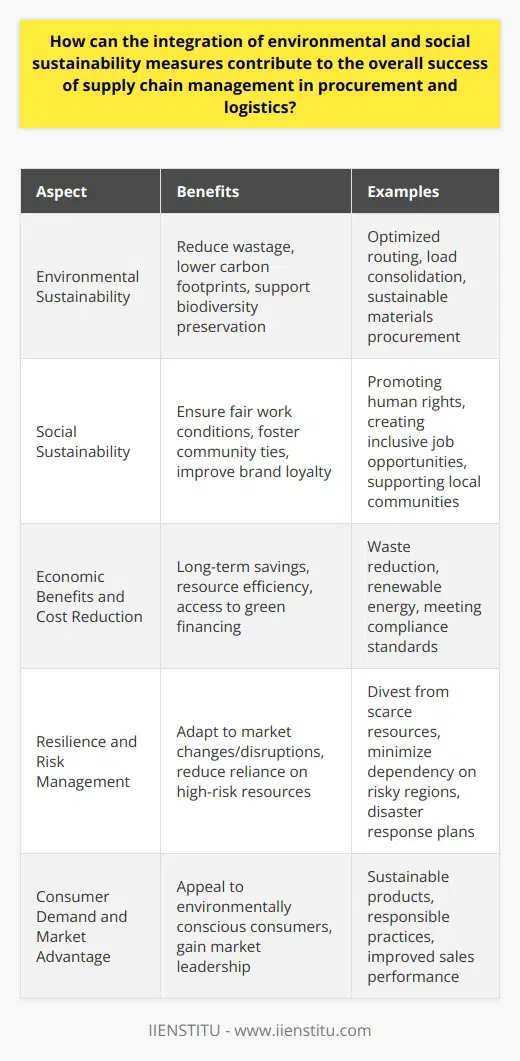
What are the key performance indicators (KPIs) to monitor in order to ensure effective logistics and procurement in supply chain management?
KPIs for Effective Logistics Management
In order to ensure effective logistics and procurement in supply chain management, key performance indicators (KPIs) should be monitored consistently. These KPIs serve as quantitative metrics that gauge the success of various operations within the supply chain.
On-Time Delivery Rates
One crucial KPI to track is the on-time delivery rate, which measures the proportion of shipments reaching their designated destinations within the pre-agreed time frame. This directly reflects the efficiency of transportation and distribution processes, impacting customer satisfaction levels.
Inventory Turnover Ratio
Another significant KPI is the inventory turnover ratio, which highlights the number of times inventory is sold and replaced during a given period. A higher turnover rate implies an effective inventory management process, allowing companies to minimize holding costs and prevent stock-outs or obsolescence.
Order Accuracy
Monitoring order accuracy is essential in maintaining an efficient supply chain. This KPI quantifies the proportion of orders delivered without errors, such as incorrect items, quantities, or damaged goods. High order accuracy rates not only improve customer satisfaction but also reduce financial losses caused by returns or replacements.
Procurement Cycle Time
Evaluating procurement cycle time can help pinpoint potential bottlenecks or redundancies in the sourcing process. Shorter cycle times indicate a more efficient procurement process, allowing faster responsiveness to changing market conditions.
Transportation Costs
Keeping track of transportation costs enables organizations to identify potential cost reduction opportunities and optimize carrier or routing selections. Lower transportation expenses lead to overall reduced supply chain costs without compromising the quality of goods or delivery times.
Supplier Performance
Measuring supplier performance, such as on-time delivery rates or quality compliance, is vital to ensure strong relationships and maintain high-quality sourced goods. Continuous assessment of suppliers enables organizations to make more informed decisions regarding their procurement strategy.
Conclusion
In conclusion, monitoring KPIs such as on-time delivery rates, inventory turnover ratios, order accuracy, procurement cycle time, transportation costs, and supplier performance are vital to ensure effective logistics and procurement in supply chain management. By regularly tracking these KPIs, supply chain managers can identify areas for optimization and establish more efficient, cost-effective operations.

How do inventory management techniques contribute to optimizing logistics in supply chain operations?
**Inventory Management Techniques**
Effective inventory management techniques play a crucial role in optimizing logistics within supply chain operations. By implementing robust systems and strategies, businesses can improve their overall efficiency and reduce operational costs.
**Demand Forecasting and Planning**
One significant aspect is accurate demand forecasting and planning, which involves analyzing historical sales data and considering factors like seasonality, trends, and market conditions. This helps companies to anticipate customer needs and make informed decisions about production levels and inventory quantities, leading to reduced stockouts, increased customer satisfaction, and lower carrying costs.
**Just-in-Time Inventory**
Another valuable inventory management technique is Just-in-Time (JIT) inventory, a strategy designed to minimize inventory holdings by delivering materials, components, and products exactly when they are needed. This reduces storage costs, prevents obsolescence and overstocking, and enhances cash flow. JIT also allows businesses to react more quickly to fluctuations in demand, ensuring supply chain efficiency and effectiveness.
**Safety Stock Management**
Effective safety stock management is another crucial aspect of inventory control, as it involves keeping a buffer amount of inventory to accommodate potential fluctuations in demand or lead times. By regularly assessing lead times, forecasting errors, and inventory holding costs, organizations can strike a balance between meeting customer expectations and maintaining optimal inventory levels, ultimately reducing costs and minimizing potential stockouts.
**Supplier Relationship Management**
Building strong supplier relationships is also essential for successful inventory management. It enables businesses to negotiate better contracts, improve collaboration, and ensure high-quality products that arrive on time. In addition, fostering long-term supplier partnerships can lead to increased visibility throughout the supply chain, providing organizations with valuable insights into potential risks, bottlenecks, and opportunities for improvement.
**Continuous Improvement and Monitoring**
Finally, ongoing monitoring and continuous improvement should be at the core of any Inventory management operation. Companies that regularly review their inventory and logistics performance can quickly identify any areas for improvement, such as reducing lead times or refining forecasting techniques. This proactive approach helps businesses stay ahead of changing market conditions and maintain a competitive edge in their industry.
**Conclusion**
In summary, inventory management techniques are integral to optimizing logistics in supply chain operations. By adopting effective forecasting, safety stock management, JIT inventory, and supplier relationship management practices, businesses can enhance their overall efficiency, reduce operational costs, and ensure a seamless flow of goods throughout the supply chain. Continuous improvement and monitoring are also essential to adapt to changing market conditions and stay competitive in today's increasingly complex business environment.
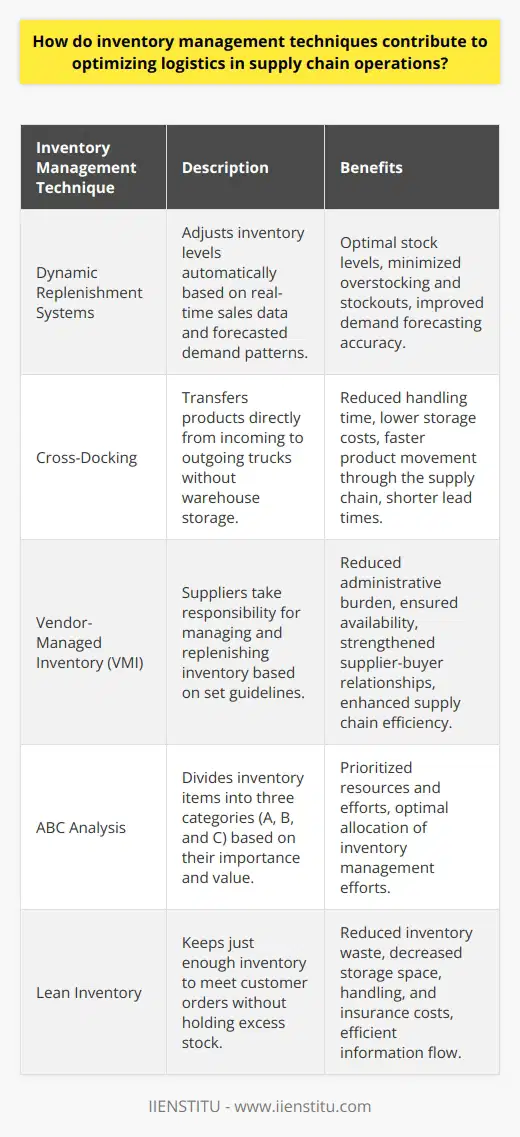
What role does supplier relationship management play in enhancing procurement optimization and achieving higher overall supply chain performance?
Significance of Supplier Relationship Management
Supplier relationship management (SRM) plays a crucial role in optimizing procurement processes and enhancing supply chain performance. By fostering strategic collaborations with key suppliers, organizations can streamline their operations, reduce lead times, and minimize costs. Consequently, efficient supplier management contributes to the overall success and competitiveness of a business.
Improved Procurement Process
A well-managed SRM program improves the procurement process through enhanced coordination, communication, and collaboration between buyers and suppliers. By actively engaging with suppliers, procurement professionals can proactively identify and address potential bottlenecks, eliminate inefficiencies, and maintain optimal product quality. Furthermore, effective supplier partnerships contribute to reducing risks, such as supply disruptions and market volatility.
Cost Reduction and Value Creation
Strong relationships with suppliers facilitate cost reduction and value creation in the supply chain. By partnering with strategic suppliers, organizations can negotiate favorable pricing, payment terms, and conditions that result in budgetary savings. Moreover, close collaboration between buyers and suppliers enables the identification of innovative solutions and strategies to jointly improve processes, drive continuous improvement, and create additional value for both parties.
Increased Flexibility and Responsiveness
SRM enhances supply chain flexibility and responsiveness by ensuring that both buyers and suppliers cooperate effectively to respond to changing market conditions, demand fluctuations, and unforeseen challenges. Through open communication and regular performance reviews, suppliers can help organizations maintain a sustainable supply chain and adapt to shifting customer needs. This collaboration results in improved order fulfillment rates, shorter lead times, and a more resilient and competitive supply chain.
Sustainability and Compliance
Finally, SRM contributes to supply chain sustainability and compliance by closely monitoring and managing supplier performance. By establishing performance metrics and guidelines for suppliers, organizations can ensure adherence to ethical, environmental, and social standards. This proactive approach to SRM significantly reduces operational risks, protects brand reputation, and contributes to achieving corporate social responsibility goals.
In conclusion, supplier relationship management is a critical component of optimizing procurement processes and ensuring overall supply chain success. By fostering strategic partnerships with key suppliers, organizations can streamline their operations, reduce costs, create value, and respond effectively to market challenges. Moreover, efficient supplier management contributes to supply chain sustainability and compliance, further enhancing the organization's reputation and competitiveness.
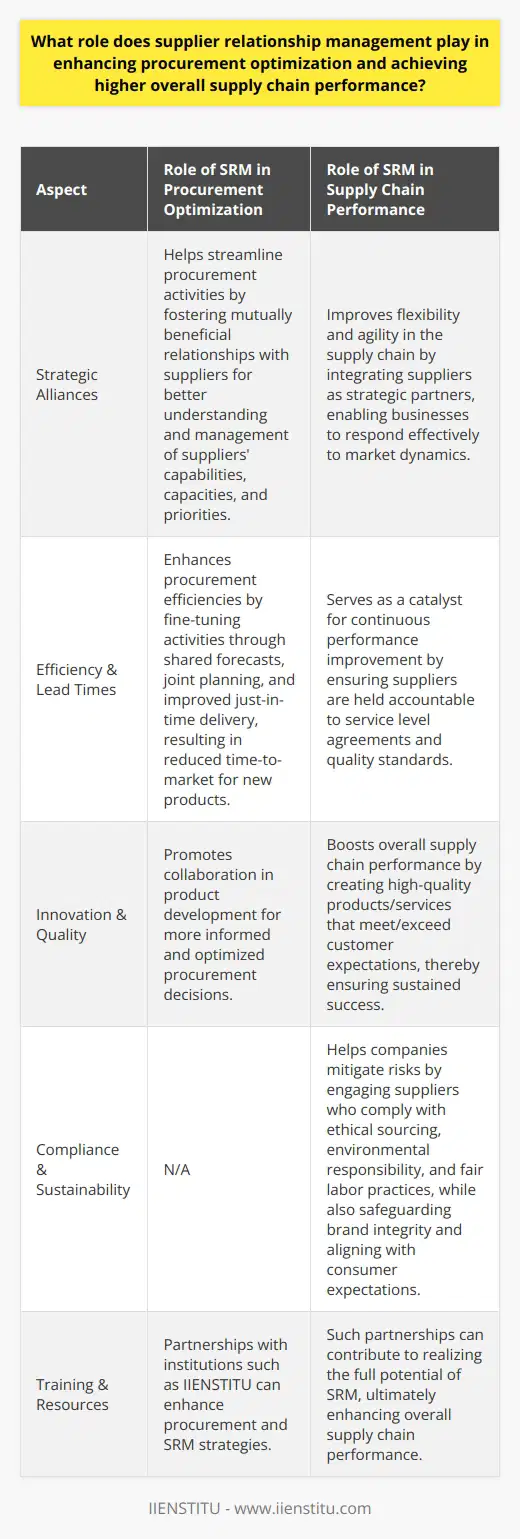
How do you optimize logistics in supply chain management to reduce costs and increase efficiency?
Optimizing Logistics in Supply Chain Management
Effective Resource Utilization
To optimize logistics in supply chain management, companies must first ensure effective resource utilization. This includes proper management of materials, labor, and equipment, as well as minimizing waste during production, transportation, and warehousing processes. By efficiently utilizing all available resources, organizations can decrease costs and increase overall productivity.
Inventory Management
Secondly, optimized inventory management plays a crucial role in reducing costs and increasing efficiency. By implementing just-in-time (JIT) principles, organizations can minimize inventory holding costs and avoid the risk of stockouts or overstocks. Accurate demand forecasting and real-time tracking of inventory levels enable companies to maintain an appropriate balance between supply and demand, leading to improved customer satisfaction and lower warehouse expenses.
Transportation and Distribution Strategies
Another critical aspect of optimizing logistics is the implementation of strategic transportation and distribution approaches. Companies should analyze their transportation networks to identify potential bottlenecks, inefficient routes, and opportunities for consolidation. By adopting multi-modal transportation options, leveraging economies of scale, and streamlining shipping processes, organizations can minimize transportation costs and increase efficiency.
Warehouse Optimization
In addition to transportation management, warehouse optimization is essential for enhancing supply chain efficiency. Companies should invest in modern warehouse management systems (WMS) to enable real-time tracking of materials, reduce errors, and improve space utilization. Automation technologies, such as robotics, can further streamline warehouse processes, reduce labor costs, and increase overall throughput.
Strong Collaboration and Partnerships
Finally, strong collaboration and partnerships among supply chain stakeholders are essential for optimizing logistics and reducing costs. By establishing strategic alliances and sharing resources, such as warehouses or transportation capacity, companies can achieve better economies of scale and minimize supply chain risks. Regular communication and alignment of objectives among supply chain partners can also contribute to improving the overall supply chain performance and subsequently increase efficiency.
In conclusion, optimizing logistics in supply chain management involves focusing on several key aspects, including effective resource utilization, inventory management, transportation and distribution strategies, warehouse optimization, and strong collaboration and partnerships. By addressing these elements, organizations can significantly reduce costs, improve efficiency, and ultimately achieve a competitive advantage in their respective markets.
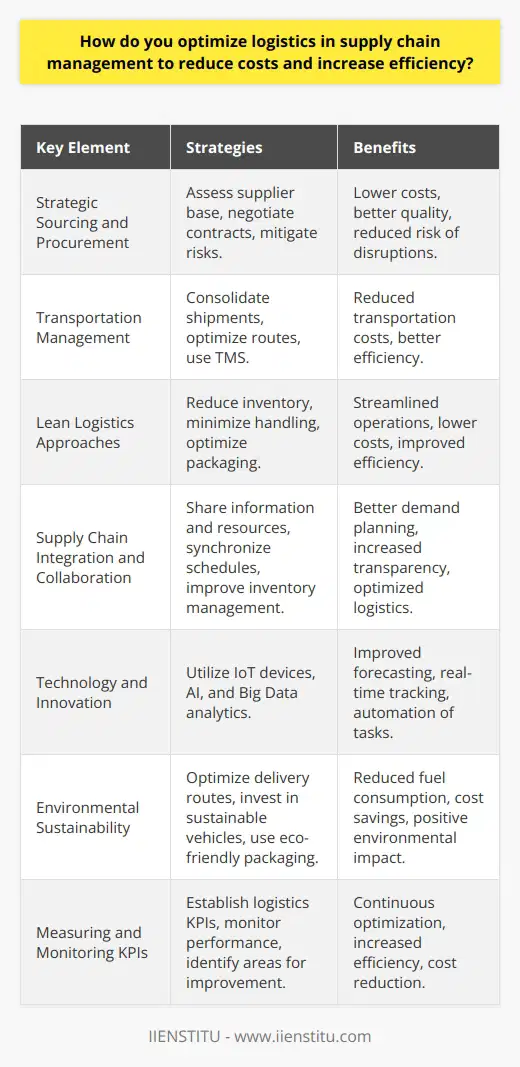
What are the key components of an effective procurement strategy for improving overall supply chain performance?
Key Components of a Procurement Strategy
Strategic Sourcing and Supplier Selection
One of the primary components of an effective procurement strategy is strategic sourcing, which focuses on analyzing and optimizing the organization's spending patterns, identifying potential savings, and reducing risks. A robust supplier selection process should be based on critical factors such as product quality, reliability, and delivery timeliness. Moreover, conducting a comprehensive supplier assessment ensures the organization partners with the most appropriate suppliers to achieve its strategic objectives.
Centralized Procurement and Standardization
Centralizing procurement activities enables organizations to establish consistency in processes and decision-making. By unifying procurement functions under one department or team, organizations can standardize their approaches, reduce duplication of effort, and consolidate purchasing power. Additionally, by standardizing their procurement processes, organizations can increase their leverage in price negotiations and streamline the entire supply chain process, resulting in overall performance improvements.
Use of Technology in Procurement
Technological advancements provide opportunities to automate and improve the procurement process. Implementation of procurement software and tools allows for efficient contract management, improved supplier collaboration, and accelerated decision-making. The use of e-procurement systems can also generate cost savings by minimizing manual processes and integrating various procurement functions onto a single platform.
Risk Management and Compliance
Effective procurement strategies should incorporate risk management protocols to anticipate and mitigate potential disruptions in the supply chain. Implementing strategies such as supplier diversification and contingency planning can help organizations maintain business continuity. Moreover, ensuring compliance with relevant regulations, ethical guidelines, and internal policies is crucial in reducing legal and financial risks associated with procurement activities.
Performance Measurement and Continuous Improvement
Measuring procurement performance is a vital element of an effective procurement strategy. Establishing Key Performance Indicators (KPIs) and tracking them regularly helps organizations monitor and evaluate their supply chain performance. Based on these data-driven insights, organizations can continuously refine and improve their procurement strategies, thereby enhancing overall supply chain performance.
Overall, the key components of an effective procurement strategy include strategic sourcing and supplier selection, centralized procurement and standardization, the use of technology, risk management and compliance, and performance measurement and continuous improvement. By incorporating these elements, organizations can significantly improve their supply chain performance and contribute to their overall business success.
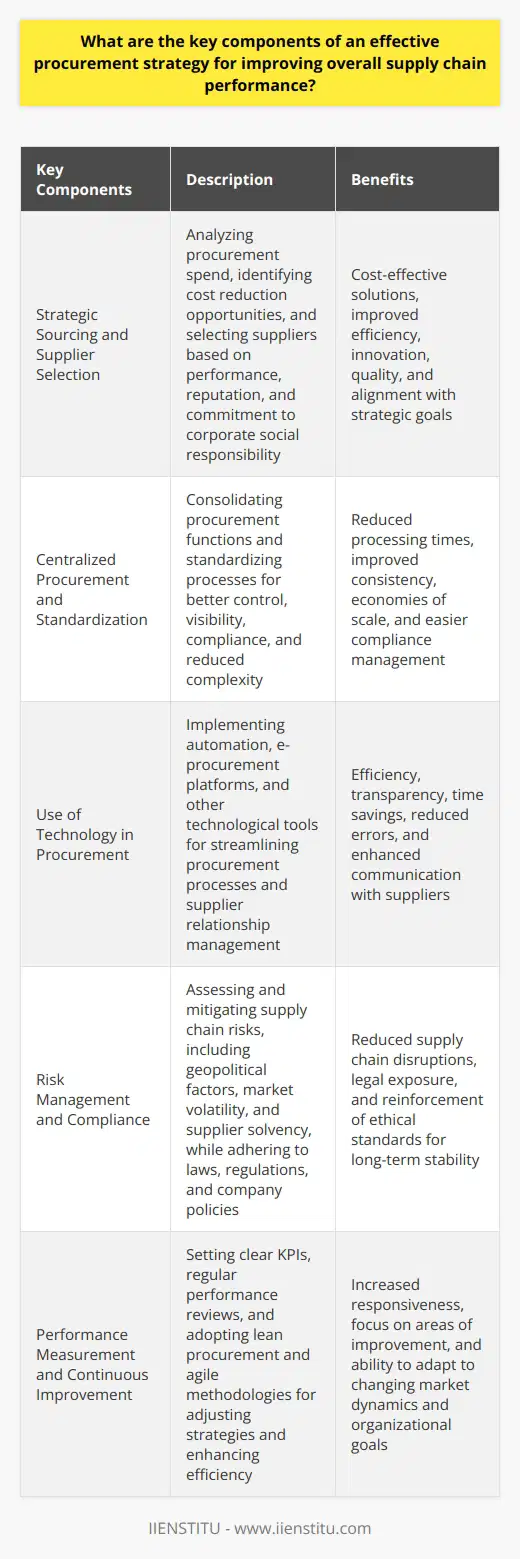
How can demand forecasting and inventory management aid in optimizing the procurement process within supply chain operations?
Demand Forecasting in Supply Chain Operations
Accurate demand forecasting plays a vital role in optimizing the procurement process. Through systematic data analysis, organizations can anticipate consumer demand patterns and efficiently allocate resources required for production, distribution, and sales. Integrating demand forecasting helps organizations avoid stockouts, reduce holding costs, and improve supply chain efficiency. Furthermore, companies can leverage historical sales data and market trends to make informed decisions, reducing the likelihood of overstocking or understocking products.
Role of Inventory Management
Effective inventory management is crucial for optimizing procurement processes and maximizing profitability. By carefully monitoring stock levels and updating procurement policies, organizations can keep their inventory levels aligned with demand fluctuations. Moreover, inventory management enables organizations to implement just-in-time (JIT) strategies, which involve purchasing materials and goods only when needed to minimize inventory costs. Consequently, supply chain operations become more agile, responsive, and aligned with market demands.
Integration of Forecasting and Inventory Management
Integrating demand forecasting and inventory management strategies can streamline procurement and contribute to overall supply chain efficiency. By maintaining optimal inventory levels, companies can minimize overstocking costs, such as storage and obsolescence expenses. Simultaneously, reduced stockout risks lead to increased customer satisfaction and retention. Additionally, organizations employing data-driven forecasting techniques can optimize their supplier relationships, negotiate better deals and prices, and establish long-term contracts, leading to improved procurement efficiency.
Implementation of Technology Solutions
Utilizing technology solutions, such as artificial intelligence (AI) and machine learning (ML), to refine demand forecasting and inventory management processes, is becoming increasingly essential. These tools can analyze large data sets and offer insights into market dynamics, seasonal variations, and customer preferences, resulting in more accurate and timely decision-making. Furthermore, incorporating real-time analytics and visibility into the procurement process enables organizations to be more proactive and responsive to changes in consumer demand.
Conclusion
In conclusion, demand forecasting and inventory management are essential components of an optimized procurement process. By effectively integrating these strategies, organizations can significantly improve their supply chain efficiencies and overall competitiveness in the market. Embracing advanced technology solutions to enhance demand prediction and inventory control will further aid companies in maintaining a streamlined and agile procurement process.
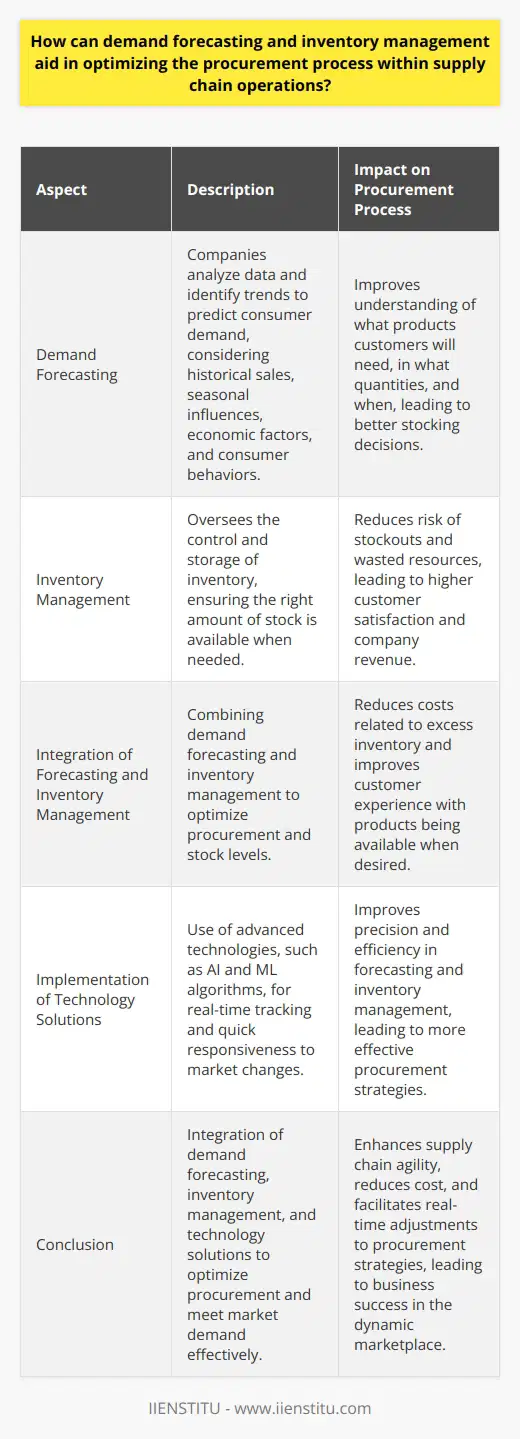
How do you optimize logistics in supply chain management to maximize customer satisfaction and minimize lead times?
Optimizing Logistics in Supply Chain Management
Effective Strategies for Maximizing Customer Satisfaction
To optimize logistics in supply chain management, it is crucial to maximize customer satisfaction by implementing effective strategies. One such approach is integrating information technology systems, which enhances visibility and communication throughout the supply chain. This not only allows for faster decision-making but also ensures that the correct products are available at the right location, thereby increasing customer satisfaction.
Leveraging Data Analytics
Another technique to increase customer satisfaction is leveraging data analytics. By collecting data from various sources, companies gain valuable insights about customer preferences and trends. This knowledge enables organizations to deliver personalized services and tailor product offerings, which lead to higher customer satisfaction rates. Furthermore, data analytics can identify potential bottlenecks within the supply chain, allowing companies to address them proactively.
Minimizing Lead Times through Lean Processes
Minimizing lead times is essential in optimizing logistics. Adopting lean and just-in-time (JIT) processing methods helps reduce inventory lead times and, consequently, respond to customer needs more promptly. Efficient warehouse management, optimized inventory control, and seamless coordination between suppliers and manufacturers contribute to reducing lead times, ultimately improving customer satisfaction.
Collaboration with Suppliers and Partners
Developing strong collaborative relationships with suppliers and partners contributes to an optimized logistics process. Establishing long-term commitments and fostering mutual trust allows for better communication, information sharing, and problem-solving. These partnerships result in a smoother flow of goods throughout the supply chain and reduced lead times.
Continuous Improvement and Adaptation
A dynamic and competitive market environment necessitates continuous improvement in logistics processes. Companies should adopt a culture focused on learning and adaptation to successfully navigate unforeseen challenges and capitalize on opportunities. Regular evaluation and revamping of supply chain processes enable businesses to maintain optimal logistics operations and achieve a perfect balance between customer satisfaction and minimal lead times.
In conclusion, optimizing logistics in supply chain management requires a blend of innovative strategies and continuous improvement. Through embracing technology, leveraging analytics, adopting lean practices, forging strong partnerships, and cultivating adaptability, companies can ensure the highest levels of customer satisfaction and shorter lead times.
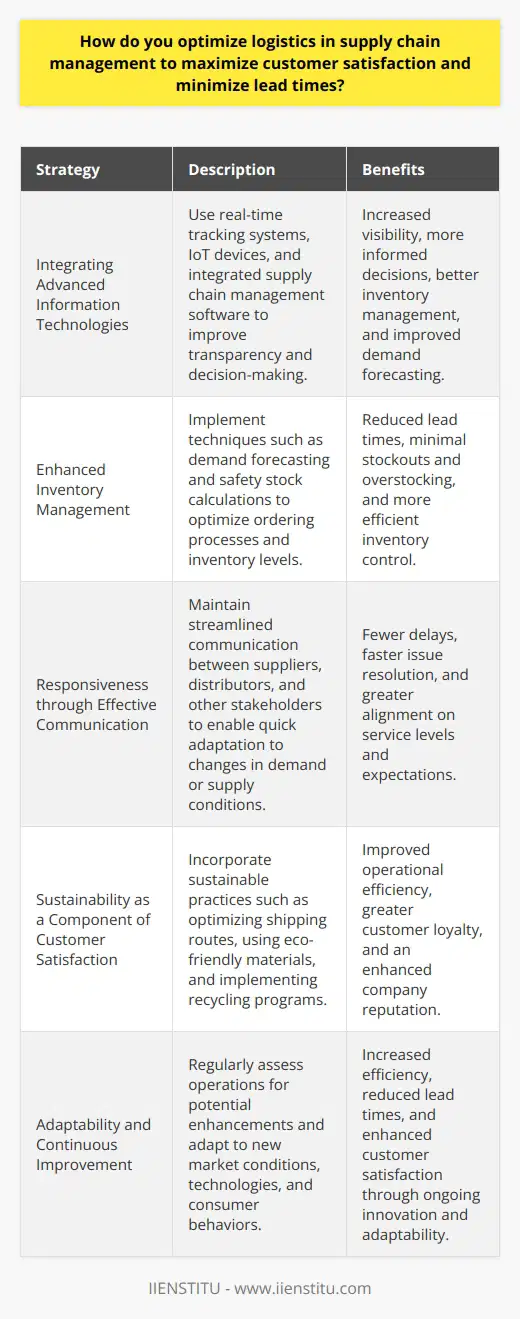
What are the essential steps in developing a comprehensive procurement optimization plan to enhance overall supply chain efficiency?
Base-lining Current Procurement Performance
The first crucial step in developing a comprehensive procurement optimization plan is to evaluate the current procurement performance of an organization. This involves identifying and understanding the key performance indicators (KPIs), such as order accuracy, cycle time, and cost savings. By benchmarking against industry standards, we can highlight areas that require improvement.
Identifying Goals and Objectives
Next, it is essential to establish clear goals and objectives for the procurement optimization plan. These should be aligned with the organization's overall supply chain strategy and must be specific, measurable, achievable, relevant, and time-bound (SMART). Furthermore, procurement goals should focus on enhancing operational efficiency, cost savings, and supplier performance.
Mapping Processes and Identifying Opportunities
Once the objectives are set, the next step involves mapping the existing procurement processes and identifying potential areas for improvement. This includes examining the complete procurement lifecycle, from sourcing and supplier selection to contract management, order processing, and payment. Identifying process inefficiencies and bottlenecks can provide valuable insights into streamlining procurement operations.
Leveraging Technology for Procurement Optimization
Incorporating technology into the procurement optimization plan is vital for improving the overall efficiency of the supply chain. Utilizing procurement software solutions, such as e-procurement and e-sourcing platforms, can automate the procurement process and reduce manual errors. Moreover, adopting advanced technologies, such as artificial intelligence (AI), can further enhance procurement decision-making and enable data-driven analytics.
Developing Effective Supplier Relationships
A successful procurement optimization plan also focuses on establishing strong relationships with suppliers. By developing long-term, collaborative partnerships with key suppliers, organizations can ensure the procurement process operates more efficiently. Additionally, supplier relationship management (SRM) measures, such as performance evaluations and regular communication, can facilitate continuous improvement in the supply chain.
Implementing a Continuous Improvement Strategy
Lastly, it is critical to continuously monitor and assess the effectiveness of the procurement optimization plan. Implementing a continuous improvement strategy, which involves regular progress reviews and data analysis, can help identify areas where further enhancements can be made. This ensures that the procurement optimization plan remains dynamic and evolves with the ever-changing supply chain landscape.
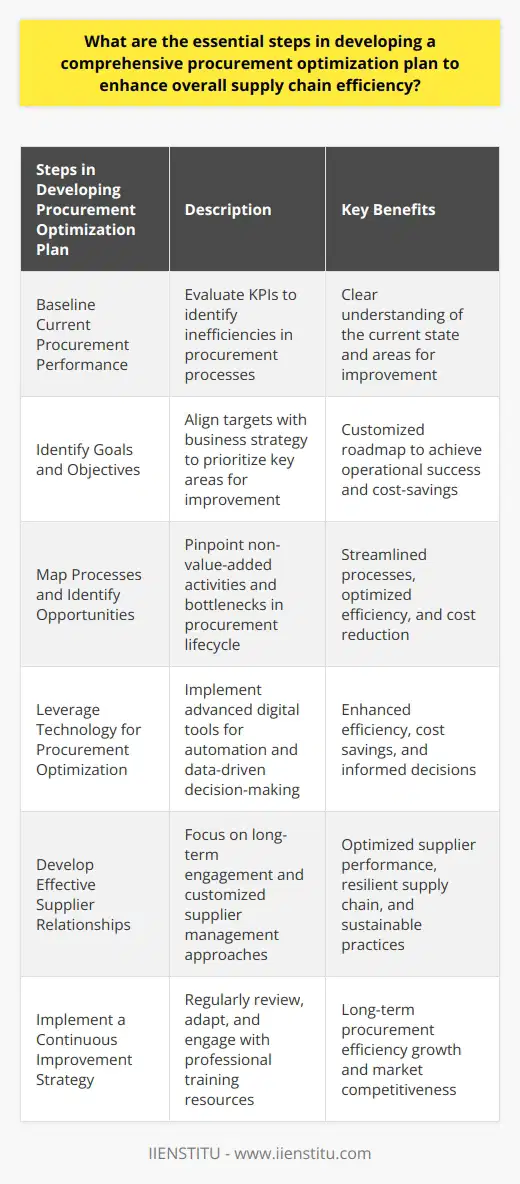
How can collaboration and communication among supply chain stakeholders contribute to more effective procurement and logistics strategies?
Enhanced Stakeholder Collaboration
Collaboration and communication among supply chain stakeholders can significantly contribute to the development of more effective procurement and logistics strategies. By fostering close relationships and open communication channels, stakeholders can align their objectives and coordinate activities more efficiently. This alignment enables the identification of potential bottlenecks and inefficiencies in the supply chain, thus providing valuable insights for strategic improvements.
Increased Information Sharing
Furthermore, collaboration promotes the sharing of critical information between the various stakeholders, including suppliers, manufacturers, distributors, and retailers. Effective exchange of data related to demand forecasting, production planning, and inventory management can optimize procurement and logistics processes. Stakeholders can make data-driven decisions, minimizing risks, reducing lead times, and improving overall supply chain performance.
Innovation Through Collaboration
Working closely together and maintaining strong communication channels can lead to the development of innovative procurement and logistics solutions. By understanding the unique challenges faced by other stakeholders, partners can identify new methods and technologies to address these issues. This collaborative process can generate innovative solutions that can increase the efficiency and effectiveness of the entire supply chain.
Sustainability and Social Responsibility
Effective collaboration and communication can also contribute to more sustainable and socially responsible procurement and logistics strategies. By engaging with stakeholders, organizations can better understand the environmental and social impact of their supply chain operations. This awareness can lead to the adoption of greener practices and the development of more ethical procurement policies.
Resilience Against Disruptions
Finally, strong communication and collaboration among supply chain stakeholders can enhance the resilience of procurement and logistics operations against disruptions like natural disasters, political unrest, or global health crises. Collaborative risk management and contingency planning can prepare organizations for unforeseen events and minimize the impact of these disruptions on their supply chain performance.
In conclusion, fostering collaboration and communication among supply chain stakeholders can lead to more effective procurement and logistics strategies. Enhanced stakeholder relationships, increased information sharing, innovation through collaboration, sustainability, and resilience against disruptions are key benefits derived from collaborative supply chain management.
